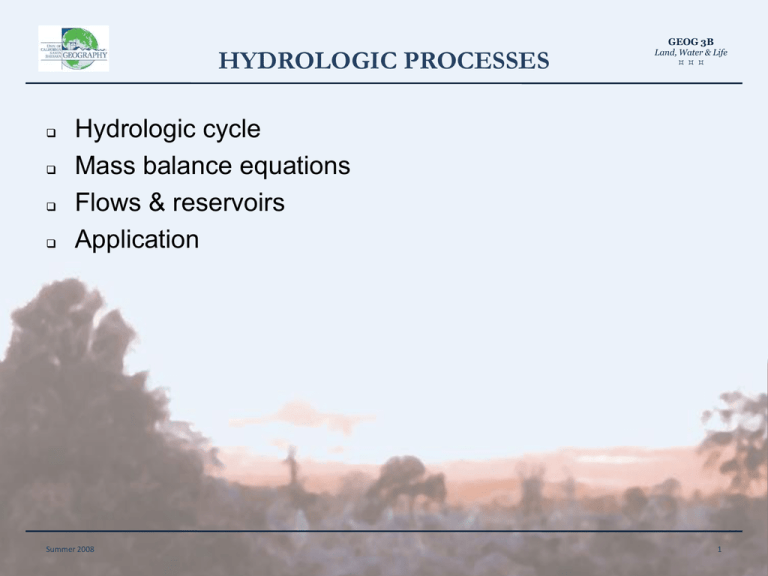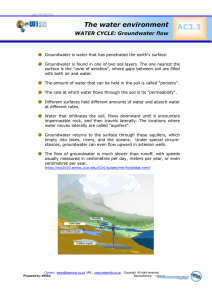Hydrologic cycle Mass balance equations Flows
advertisement

HYDROLOGIC PROCESSES GEOG 3B Land, Water & Life Hydrologic cycle Mass balance equations Flows & reservoirs Application Summer 2008 1 2 HYDROLOGIC CYCLE GEOG 3B Land, Water & Life Hydrologic cycle: Hydrology is the study of the movement, distribution, and quality of water throughout the earth; the hydrologic cycle describes the continuous movement of water above, on, and below the surface of the Earth. We may identify various components of the hydrologic cycle, including: Summer 2008 Atmospheric Component Vegetation Component Surface Component Soil Component Groundwater Component 3 4 HYDROLOGIC CYCLE GEOG 3B Land, Water & Life The hydrologic cycle is a closed system Water is essentially neither created nor destroyed as it flows through various environments near the Earth's surface Small amount of water is lost to space Small amounts of water are lost/gained from chemical reactions Each component of the HC contains: Reservoirs [ ΔS ] Flows [ Inputs & outputs ] We can write Mass Balance Equations to represent the Flows of Water. Consider water flowing into and out of any arbitrarily chosen volume near to the Earth Surface. It will always be true that: INPUT - OUTPUT = CHANGE IN STORAGE ( I - O = ΔS ) Summer 2008 5 MASS BALANCE EQUATIONS 6 7 MASS BALANCE EQUATIONS GEOG 3B Land, Water & Life We can represent the hydrologic Mass Balance of Water at different spatio-temporal scales: Micro Scale (meters) Macro Scale (kilometers) Global Scale Balance: Summer 2008 Precip = Evap + GrndwtrFlo + Runoff 8 9 10 FLOWS & RESERVOIRS 11 ATMOSPHERIC COMPONENT GEOG 3B Land, Water & Life Flows and Reservoirs of the Atmospheric Component: Input: Evapo-transpiration Output: Precipitation Storage: Air At global scale: Precipitation approximately 39in/year 1in water held in Atmosphere Precipitation varies by Climatic Zones At regional scale Variation in Precipitation by Landform/Elevation Inverse relation of Precipitation Intensity and Duration Summer 2008 12 13 14 15 VEGETATIVE COMPONENT GEOG 3B Land, Water & Life Main flows and reservoirs of the vegetation component Input: Precipitation, plant roots Output: Stemflow, transpiration Storage: Roots, leaves, stems, etc. Approximately 10-29% Precipitation is intercepted or evaporates Interception generally declines sharply over time during Precipitation Event Summer 2008 16 17 18 LANDSURFACE COMPONENT GEOG 3B Land, Water & Life Main flows and reservoirs of the surface component Input: Precipitation, stemflow, surface runoff, soil/groundwater outflow Output: (Soil) infiltration, runoff, evapotranspiration Storage: Surface depressions, rivers, lakes Evaporation rates approximately 15” /year in NE USA to 90” /year in SW USA Summer 2008 19 20 21 22 23 Mean daily solar radiation Mean annual lake evaporation Mean annual ET 24 LANDSURFACE COMPONENT GEOG 3B Land, Water & Life Surface runoff is one of the most processes in terms of the evolution of landforms Surface runoff is: Water remaining from rainfall after evapotranspiration and Infiltration Augmented by Water flowing from Soils and Aquifers Surface runoff takes two major forms: Overland Flow Streamflow Streamflow may be characterized in terms of: The stream hydrograph which represents the variations of Stream Discharge over time (at a given location) Various flows, such baseflow and flood flow Summer 2008 25 26 27 28 29 30 31 32 33 34 SOIL WATER COMPONENT GEOG 3B Land, Water & Life Main flows and reservoirs of the soil component: Input: Infiltration from surface, soil/groundwater Inflow Output: Evapotranspiration, soil/groundwater outflow Storage: Soil particles, porespaces Soil Water occurs in three forms Hygroscopic Water Capillary Water (up to the Field Capacity of a Soil) Gravitational Water Summer 2008 Infiltration is a key process that determines how much surface runoff occurs in a given rainfall event Infiltration capacity represents the rate at which soil can absorb rainfall under various rainfall rates 35 36 37 SOIL WATER COMPONENT GEOG 3B Land, Water & Life Capillary water Summer 2008 Force underlying capillary water results from attraction to surfaces/water molecules pressures of 0.3-32 bars Field capacity is the maximum amount of capillary water that can be held in a soil and is related to particle size Capillary flow from high to low moisture content maximum transport in medium sized particles Height travelled by capillary water determined by balance of gravity/molecular forces 38 SOIL WATER COMPONENT Soil infiltration: GEOG 3B Land, Water & Life The rate at which water infiltrates into a soil determines how much surface runoff, and hence erosion, can occur The rate of infiltration of a soil under given rainfall conditions is represented by the concept infiltration capacity Infiltration capacity is determined by the various soil properties, such as texture Other concepts: Summer 2008 Soil-water budget 39 40 Summer 2008 41 42 43 GROUNDWATER COMPONENT GEOG 3B Land, Water & Life Main flows and reservoirs of the groundwater component Summer 2008 Input: Soil/groundwater inflow Output: Evapotranspiration, soil/groundwater outflow, runoff Storage: Pore spaces, fissures, ... 44 45 GROUNDWATER COMPONENT GEOG 3B Land, Water & Life Aquifers Rocks that hold groundwater are called aquifers Most water enters an aquifer from soils at the surface Their upper unsaturated portion is called the Vadose Zone They are typically charactized by: A Water Table, which is the level at which the rocks are saturated with water Groundwater Flow Summer 2008 46 47 48 49 GROUNDWATER COMPONENT GEOG 3B Land, Water & Life The amount of Groundwater that may be held in an Aquifer depends on the porosity of the rock The flow of water through an aquifer (groundwater flow) is determined in part by the permeability of the rock There are two main classes of Aquifer depending on on the configuration of Permeable and Impermeable Rock Layers Unconfined Aquifer Confined Aquifer Summer 2008 50 51 52 53 GROUNDWATER COMPONENT GEOG 3B Land, Water & Life The flow of water in an Aquifer can be approximately described by Darcy's Law: Q = A* K [Δ h/ Δ x] where: K is hydraulic conductivity Δ h is drop in Head Δ x is distance of flow A is Area of flow Summer 2008 54 55 GROUNDWATER COMPONENT GEOG 3B Land, Water & Life Other concepts: Summer 2008 Transmissibility Springs 56 57 58 59 APPLICATION OF HYDROLOGY GEOG 3B Land, Water & Life Flood forecasting / watershed management Groundwater availability / management Saltwater intrusions Pollution / remediation Summer 2008 60 61 62 63 64 65 66 67 NTS PROJECT – SAN DIEGO CREEK WATERSHED Orange 56 San Diego Creek Watershed Boundary 54 55 64 67 Pe t s er C a on y n W Creek Sa n 53 o o eg 27 eg i San D 13 Di 46 62 h Project Sites 26 Upper Newport Bay as C re ek Lake Forest 39 Newport Beach Type 1- Offline Water Quality Wetlands Type 2 - Inline Water Quality Wetlands N 0 2 4 Miles Type 3 - Water Quality Wetlands within Existing or Proposed Detention Basin 68 69 70 71 72 73





